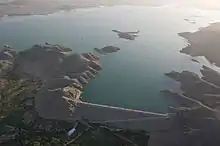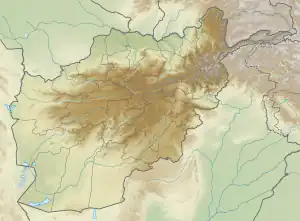Dahla Dam
The Dahla Dam, also known as Arghandab Dam and Kasa,[1] is located in the Shah Wali Kot District of Kandahar Province in Afghanistan, approximately 40 kilometres (25 mi) north of the provincial capital Kandahar.[2] Constructed in 1952, it is said to be the second largest dam in Afghanistan. As of 2019, the Afghan government is spending $450 million on making the dam more useful. The project includes raising the dam's walls by 12 meters so its reservoir can hold nearly a billion cubic meters of fresh water and installing three turbines for the production of 22 megawatts (MW) of electricity.[3][4][5]
| Dahla Dam | |
|---|---|
 Aerial view of the Dahla Dam in 2012 | |
 Location of Dahla Dam in Afghanistan | |
| Location | Shah Wali Kot District, Kandahar Province, Afghanistan |
| Coordinates | 31.855544°N 65.892413°E |
| Opening date | 1952 |
| Dam and spillways | |
| Impounds | Arghandab River |
| Height | 55 metres |
| Length | 535 metres |
The Dahla Dam is built on the Arghandab River which flows over a length of 250 miles (400 km).[6] Over the years its reservoir was subject to siltation, and its canal system reduced irrigation benefits. This necessitated undertaking rehabilitation of the dam which involved desiltation works and pertinent components of the project to improve the water delivery system; this component was completed during March 2012 with assistance provided by Canada. The second phase involved raising the height of the dam and the relevant dykes to compensate for the loss of storage in its reservoir due to siltation, and to achieve the full benefits of irrigation for which the dam was originally built.[7][8][9][10]
History
The Dahla Dam was originally built between 1950 and 1952 when relations between Afghanistan and the United States were beginning to quickly develop. The purpose of the dam was to help farmers in Kandahar Province and provide clean drinking water to the city of Kandahar.[11][6]
The Dahla Dam is an embankment structure made of earth and rock fill. It is 55 metres (180 ft) in height. The length of the dam at the crest is about 535 metres (1,755 ft). In the periphery of the dam six saddle dams have been built which together measure 2,040 metres (6,690 ft) and with varying heights of 15–25 metres (49–82 ft). To pass the design flood discharge two spillway structures have been built. To release water for irrigation to the canal system low level sluices have been built at the downstream toe of the dam with two control valves of the Howell-Bunger type which function as energy dissipation bypass valves.[12]
The reservoir created by the dam has a storage capacity of 314 MCM.[6][9] The irrigation system designed to provide irrigation to 30,000 hectares (74,000 acres) of land in the Kandahar province consisted of 77.6 kilometres (48.2 mi) of the main canal and 415 kilometres (258 mi) of branch canals; with the main canal designed to carry a discharge of 42.5 cubic metres (1,500 cu ft) per second. The contractor for the project was Morrison-Knudsen Afghanistan Incorporated. The dam and the irrigation system are under the control of the Helmand and Arghandab Valley Authority.[11]
Rehabilitation and expansion

After completion of the dam in 1952, it functioned well for many decades. However, the irrigation system and its operation was neglected during the 1980s Soviet occupation.[10] A technical appraisal of the status of the project carried out by experts from Agriculture and Agri-Food Canada in 2008 revealed that the siltation in the reservoir had resulted in reduction of the storage capacity by 34%, irrigation system had deteriorated resulting in loss in canal discharge to the extent of 70% on account of siltation, evaporation, seepage and other defects. The intake tower of the dam was not functioning properly and control valves were leaking, spillway capacity to discharge flood waters was inadequate, and there was no operational plan.[9][13] Even before the rehabilitation of dam and canal system could be initiated, as first priority the mines in the rocky areas of the reservoir area had to be cleared which was done by the U.S. Army Corps of Engineers. After this operation, a two-phase rehabilitation plan was launched.[6]
On completion of the rehabilitation works by raising the height of the dam and related appurtenant works, and the improvements of the canal system, the volume of available water would be increased from 300 million cubic meters to 484 million cubic meters. This would facilitate irrigation to command areas in the districts of Shah Wali Kot, Arghandab, Zheri, Panjwai, Maiwand, Dand and Daman, and also help in planning and building a 10 MW capacity hydropower station to generate electricity.[14]
Phase 1
In the first phase the rehabilitation works were carried out by Canada during the period from 2009 to 2012 under the project titled "Arghandab Irrigation Rehabilitation Project" at a cost of nearly $44 million US dollars. Desilting and repairs to 77.6 kilometres (48.2 mi) of main canal and about 415 kilometres (258 mi) of branch and minor canals, replacement of water valves and erecting gates to improve control over the flow of water supplying to farm fields from the reservoir of the Dahla Dam were carried out.[8]
Phase 2
Raising the height of the dam is seen crucial to increasing the volume of available water, which has reduced to around 290 million cubic meters from about 500 million cubic meters water.[3] The rehabilitation work during this phase involved raising the height of the dam by 8 metres (26 ft), of saddle dams by 5–6 metres (16–20 ft), spillways, and modifying structural, hydraulic and electro-mechanical features. The work was initiated by the U.S. Army Corps of Engineers but then abandoned due to a financial issue with the Afghan government.[10][6]
Phase 3
The third phase of the project was scheduled to be completed in 2024.[3] In this regard, former deputy Minister of Energy and Water Abdul Basir Azimi stated the following:
The third phase of the project will provide water to Kandahar City. It will help hundreds of thousands of families to have access to drinking water after it is processed. Meanwhile, three turbines will be installed on the dam. Each of them will produce eight megawatts of power. All the turbines will generate 22 megawatts of power.[4]
According to Toryalai Mahboobi, Kandahar basin chief, the reservoir of Dahla Dam would have 950 million cubic meters of fresh water after the third phase of the project is completed.[3]
References
- "Ambitious development on fragile foundations: Criticalities of currentlarge dam construction in Afghanistan". www.academia.edu. 2014. p. 51. Retrieved 2019-04-01.
- "Dahla Dam reconstruction gives hope to Kandahar farmers". Pajhwok Afghan News. February 24, 2011. Archived from the original on 2019-05-06. Retrieved 2019-05-06.
- "Kandahar's Dahla Dam expansion project to begin soon". Pajhwok Afghan News. May 1, 2019. Archived from the original on 2019-08-27. Retrieved 2019-05-06.
- "Ministry To Invest $450 Million In Kandahar Dam Project". TOLOnews. July 6, 2018. Retrieved 2019-04-01.
- "'Extra water maybe released from filled Dahla Dam soon'". The Frontier Post. March 9, 2019. Retrieved 2019-04-01.
- "Army Corps of Engineers to raise Dahla Dam and provide water essential to southern Afghanistan". Professional Overseas Contractors. 21 July 2014. Retrieved 12 November 2015.
- "Dahla Dam's future at risk as Canada ends work in Afghanistan: report". CBC News. 15 November 2014. Retrieved 15 November 2014.
- "Project profile: Arghandab Irrigation System Rehabilitation". Foreign Affairs, Trade and Development Canada. Archived from the original on 4 March 2016. Retrieved 12 November 2015.
- Melliger, Joshua J. "Identifying and Evaluating Irrigation Dams in Afghanistan" (PDF). Society of American Military Engineers, Society of American Military Engineers Omaha Post. Archived from the original (PDF) on 2016-03-04. Retrieved 12 November 2015.
- "The Dahla Dam Project: A Status Update of a USA Funded Project in the Early 1950s for Agricultural Irrigation in the Kandahar Province, Afghanistan". Earth and Environment Science. 21 January 2015. Retrieved 12 November 2015.
- "The Dahla Dam". Morrison and Knudsen Corporation. Archived from the original on 18 November 2015. Retrieved 12 November 2015.
- "Y--Dahla Dam Improvement Project, Kandahar Province, Afghanistan". Federal Business Opportunities. 24 June 2011. Retrieved 12 November 2015.
- "Executive Summary - Arghandab Irrigation Rehabilitation Project". Foreign Affairs, Trade and Development Canada. Retrieved 12 November 2015.
- Naadim, Basher Ahmad (28 June 2015). "Dahla Dam project first phase nears completion". Pajwok Afghan News. Archived from the original on 1 April 2019. Retrieved 12 November 2015.
External links
- Satellite detected water extent and evolution, as of 04 March 2019 over Arghandab Dam, in Shah Wali Kot District, Kandahar Province, Afghanistan.
- Dahla Dam Irrigation Release (YouTube video by Bryan Construction Inc)
- US ARMY CORPS OF ENGINEERS & 77 CONSTRUCTION COMPANY DAHLA DAM IMPROVEMENT PROJECT PHASE 1 (YouTube video by U.S. Corps of Engineers)
